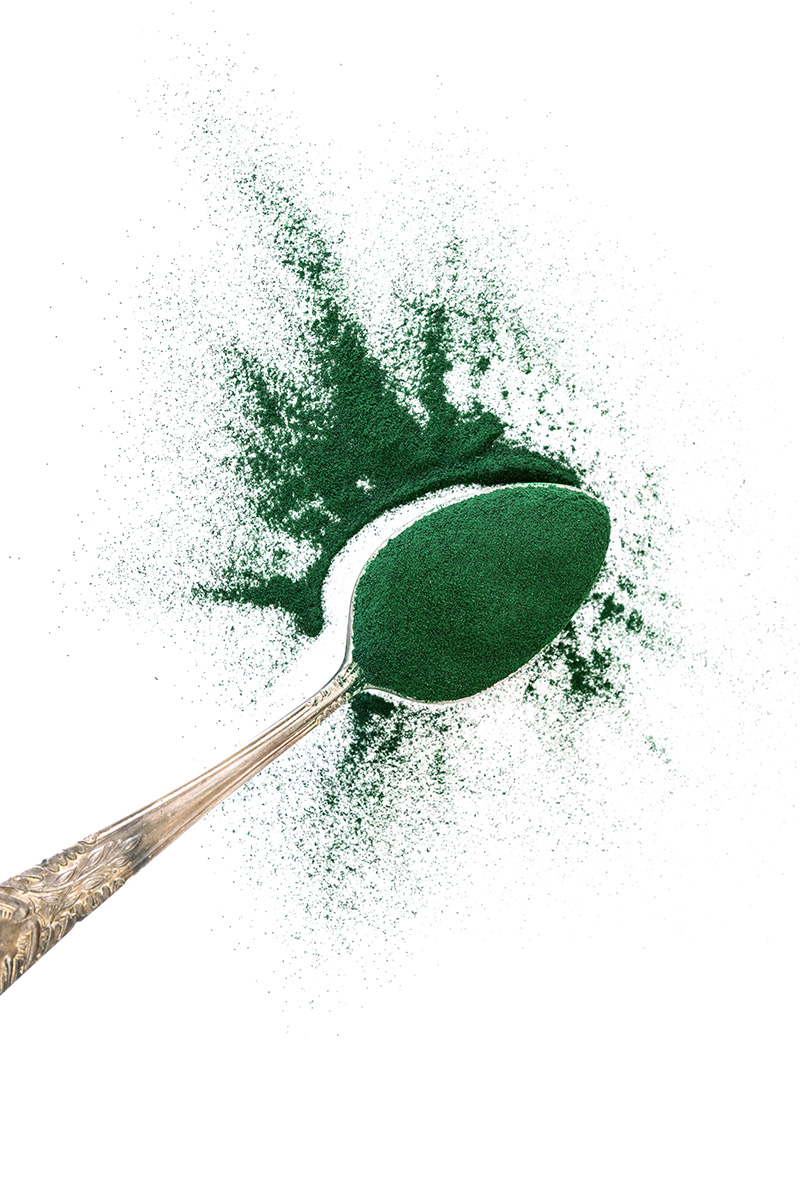Spirulina
Spirulina

What exactly is
Spirulina?
Spirulina is a single-celled photosynthetic micro-organism that originated billions of years ago by developing the ability to absorb dissolved carbon dioxide in the sea as nutrients. It is a cyanobacter or microalga that grows in highly alkaline conditions and high light intensity. Infinitely smaller than the Algae family, to which it is similar in the way it grows and develops, Spirulina is characterized by the spiral shape of its appendages, visible only under a microscope, and by the peculiarity of being able to produce proteins, essential fatty acids , vitamins and minerals from sunlight and from nutrients such as nitrates and phosphates.
The earliest records of Spirulina's use date back to the Spanish invasion of Mexico; the conquistadors noticed the Aztecs harvesting a food unknown to them from the surface of the lake. Local fishermen accumulated a blue-colored biomass in very fine mesh nets, from which they made a thick paste for food use, Techuitlatl.Legends tell that Aztec messengers used Spirulina as a source of energy during their long journeys.
Early analyses of Spirulina's nutritional characteristics showed its exceptional protein content (up to 60-70% on dry weight)characterized by high quality due to a broad and complete amino acid profile.
The lack of cellulose wall increases the digestibility of the raw product and the bioavailability of the active ingredients, which can then be efficiently assimilated or extracted.
Livegreen Spirulina has a biochemical composition that makes it a very balanced food and an ecologically excellent agent. In a CO2-producing industry such as agribusiness, the cultivation of Spirulina contrasts with the absorption of the gases produced and the natural production of O2, ending its cycle with an emerald green Carbon Footprint.
As Spirulina is grown in aquacultures instead of on land, the release of arable land and the continuous recycling of water further turns in its favor.
What does Spirulina contain?
Protein
Pivotal elements of our body, they serve to give it a healthy and strong structure, as well as contribute to satiety, thus helping us eat less;
B and E vitamins
They play a key role in the development of all the body's structures, including nerve tissue, especially in the growing years;
Beta-carotene
Has a powerful antioxidant action on the body, having a beneficial effect on eyes, teeth, nails and membranes in general;
Minerals
Potassium, magnesium, zinc and especially iron, which are essential for the general health of the body;
Phycocyanin
Protein with potent anti-inflammatory and antioxidant activities.
Omega6
Essential fatty acids that are needed to support the action of Omega3, prevent cardiovascular disease, detoxify the liver and promote cell regeneration
Livegreen Italian Spirulina is grown in large tanks located in closed greenhouses and follows several steps in its production:
- the harvesting: through a special filtering system, the Spirulina is harvested and separated from the growing water, then recovered and put into the tank again; a thick green cream results;
the squeezing: the green, jam-like cream is subsequently pressed and squeezed;
the formation of spaghettini: through a special drawing machine, the Spirulina is then transformed into long strands we call "spaghettini," which break apart naturally, creating the versatile and characteristic format;
thedrying at low temperatures: an essential process to keep intact all the properties of Spirulina, which would otherwise be compromised by too high temperatures.
Spirulina - and not “sbirulina” - has a funny name derived from its spiral shape. Looking at it under a microscope, in fact, Spirulina turns out to be composed of microfilaments that look like spirals, more or less dense, constantly moving through the water.
Saltwater cultivation of Spirulina, which is widely spread especially on the American continent, mean that the product ends up absorbing Iodine from its growing ecosystem. However, in itself Spirulina is a photosynthetic organism of fresh water and of itself does not contain that often negative iodine for health. Being that our Spirulina grown in purified groundwater, this problem does not arise, and Livegreen Spirulina is therefore completely iodine-free.
This makes it a food with no contraindications for those suffering from hyperthyroidism or any thyroid disorder.
Recognized as a food by the EFSA (European Food Safety Agency), Spirulina is not a dietary supplement. Some of its formats, such the widely used tablets, might give this idea, but Spirulina remains for all intents and purposes a food, as long as it is free of additional additives.
Almost, but not quite. Spirulina consists of colonies of Arthrospira Platensis and Spirulina Maxima, microscopic organisms belonging to the photosynthetic cyanobacteria family. It is therefore a plant-like natural food, sharing in it chlorophyll photosynthesis, although it is not, by definition, a plant.
Its structure is thus different, as are its organoleptic and nutritional characteristics.
Spirulina is not one of those foods whose overdose is likely to give problems. Because it is an all-natural food that is free of elements that are harmful to the body, the intake one can make of Spirulina is comparable to what one might make of a vegetable. Zucchini, beans, salad- it is common knowledge that none of these give any particular problems, even taken in large quantities; the same is true for Spirulina, which should not be understood as a dietary supplement, in fact talking about posology or dosage is a mistake, starting with terminology.
The essential element of good nutrition, however, is variability, which is essential for determining healthy, balanced meals. As much as theoretically taking Spirulina alone is enough to fulfill human nutrition, variety is still essential for a careful and balanced diet.
Spirulina as a food is absolutely safe, and has no contraindications except for those with specific health conditions: those with phenylketonuria, a genetic disorder that prevents the body from synthesizing the phenylalanine contained in Spirulina, or those on anticoagulant therapies are advised against taking Spirulina.
Actually no, as Spirulins differ both by species and by type of processing. There are different species, although the most common are Arthrospira Platensis and Spirulina maxima. The same applies to processing; slow or fast drying, thus at low or high temperatures, is only one of many factors that can determine
particularities and differences between Spirulins.
Spirulina contains vitamins in very large quantities:
- Vitamin A
- The precursor of vitamin A, beta-carotene, a carotenoid of great importance for its antioxidant activity
- B vitamins; particularly vitamins B1, B2, B3 and B6, which promote the functioning of enzymes in almost all metabolic processes of food processing
- Vitamin E, known for its antioxidant properties
- Vitamin K, with antihemorrhagic properties useful for blood clotting
In addition to a broad set of vitamins, Spirulina contains protein and minerals, including magnesium, potassium, iron, calcium and zinc stand out.
Spirulina is an ingredient of great versatility, which Livegreen does its best to exploit. Distributed in spaghettini and tablet form, among other formats, the ingredient can be used in a variety of ways, in cooking or as a beauty treatment for skin and hair.
Livegreen noodles have been described in the past with the Japanese adjective Umami, "savory," brought to define an ingredient that lies somewhere between sweet and savory. They can be mixed into a yogurt, smoothie, salad, soup, or dissolved in a little water and used in dough such as pizza, bread, pasta, and many others.
Spirulina in tablet form, on the other hand, is also considered ideal for athletes because of its convenient, easily dosed format.
Spirulina is a microalgae that can be produced either in powder or spaghetti form. The production processes of the two differ in many ways: the former is done at high temperatures while the latter is done cold, and there is actually one of the two that outperforms the other regarding the quality of the final product.
In the process of producing the powder, Spirulina is extracted from the tanks in which it is grown and is left in the sun to drip, so that it is separated from excess water. What is now comparable to a Spirulina jam is then passed through a machine that instantly dries it at temperatures above 150°C, completely removing the water and leaving only the powder. However, this process simultaneously ruins a large percentage of the vitamins.
Spaghettini, in contrast, are made at low temperatures in a cold process. Spirulina is transported to a machine that separates it from excess water, quickly but without sacrificing the product's vitamin potential. The resulting cream is then pressed with special machinery to remove the water, making it more compact and suitable for processing into noodles that keep the nutritional properties of Spirulina intact.
Livegreen People

I fell in love with the bars because it really gives me satisfaction that right after training, often, you're hungry but you can't have lunch right away or risk eating something that can then ruin your lunch.
Francesca Lollobrigida, ice skating champion

Following such a tight and strenuous training regimen, I necessarily need to rely on supplements of various kinds. Knowing that there is a natural alternative to the more classic chemical drinks is a very important thing.
Rita Cuccuru, Sardinian paratriathlon champion

I like Spirulina because it is a natural food that allows me to easily get from my daily diet the same benefits that I would get through other non-natural supplements. The taste is absolutely pleasant and this allows me to use them very easily within my daily diet.
Laura De Marco, young star of the 3000 steeplechase


